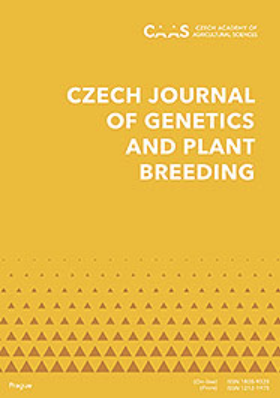Study on fine mapping of QTL for juice yield traits of sweet sorghum (Sorghum dochna)
IF 1.8
4区 农林科学
Q3 AGRONOMY
引用次数: 1
Abstract
The stem juice yield is a key factor that influences both the biological and economic production of sweet sorghum [Sorghum dochna (Forssk.) Snowden]. To elucidate upon the genetic basis of the stem juice yield, an F5 population developed from a cross between the low juice yielding Xinliang52 (XL52) and high juice yielding W455 lines, were used in a quantitative trait locus (QTL) analysis. A main effect of the QTL controlling stem juice yield was separated with an SSR marker called Xtxp97, which explained 46.7% of the phenotypic variance. In addition, F5 and F6 populations were constructed with XL52 and W452 as the parents to further verify the QTLs, and a significant correlation was found between the juice yield trait and the Xtxp97 marker. Based on the progeny tests of 29 recombinants, QJy-sbi06 was located in a region of about 21.2 kb on chromosome 6, where a candidate gene encoding an NAC transcription factor (sobic.006G147400) was identified. Combining the different population association analysis and sequencing technology showed that XL52 inserted a 1.8 kb transposon in the NAC to directly interrupt and inactivate the juice yield gene. This study also demonstrated that the colour of the leaf midribs was controlled by a single gene and was significantly positive correlated with juiciness (r = 0.784, P < 0.01). These results could lay the foundation for map-based cloning of QJy-sbi06 and provide genes or QTLs for breeding sorghum lines with a high juice yield and quality.甜高粱产汁性状QTL精细定位研究
茎汁产量是影响甜高粱生物生产和经济生产的关键因素。斯诺登)。为阐明茎汁产量的遗传基础,以低汁系新良52 (XL52)与高产系W455杂交而成的F5群体为材料,进行了数量性状位点(QTL)分析。用SSR标记Xtxp97分离出控制茎汁产量的QTL主效应,解释了46.7%的表型变异。此外,以XL52和W452为亲本构建F5和F6群体进一步验证qtl,发现产汁性状与Xtxp97标记之间存在显著相关。通过对29个重组体的子代检测,QJy-sbi06位于6号染色体约21.2 kb的区域,在该区域发现了一个编码NAC转录因子的候选基因(sobic.006G147400)。结合不同群体关联分析和测序技术发现,XL52在NAC中插入了一个1.8 kb的转座子,直接中断并灭活了产汁基因。叶中肋颜色受单基因控制,与多汁性呈极显著正相关(r = 0.784, P < 0.01)。这些结果可为QJy-sbi06的图谱克隆奠定基础,并为选育高产优质高粱品系提供基因或qtl。
本文章由计算机程序翻译,如有差异,请以英文原文为准。
求助全文
约1分钟内获得全文
求助全文
来源期刊

Czech Journal of Genetics and Plant Breeding
Agricultural and Biological Sciences-Plant Science
CiteScore
2.20
自引率
0.00%
发文量
25
审稿时长
>12 weeks
期刊介绍:
Original scientific papers, critical reviews articles and short communications from the field of theoretical and applied plant genetics, plant biotechnology and plant breeding. Papers are published in English.
 求助内容:
求助内容: 应助结果提醒方式:
应助结果提醒方式:


